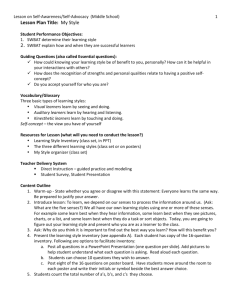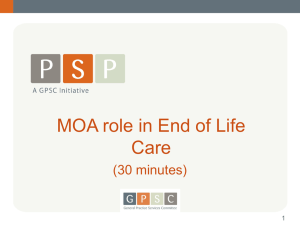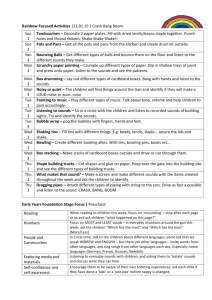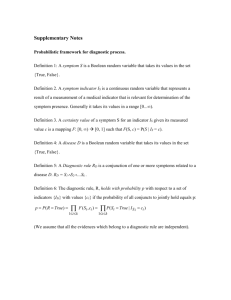An exploration of the pilot implementation of an
advertisement
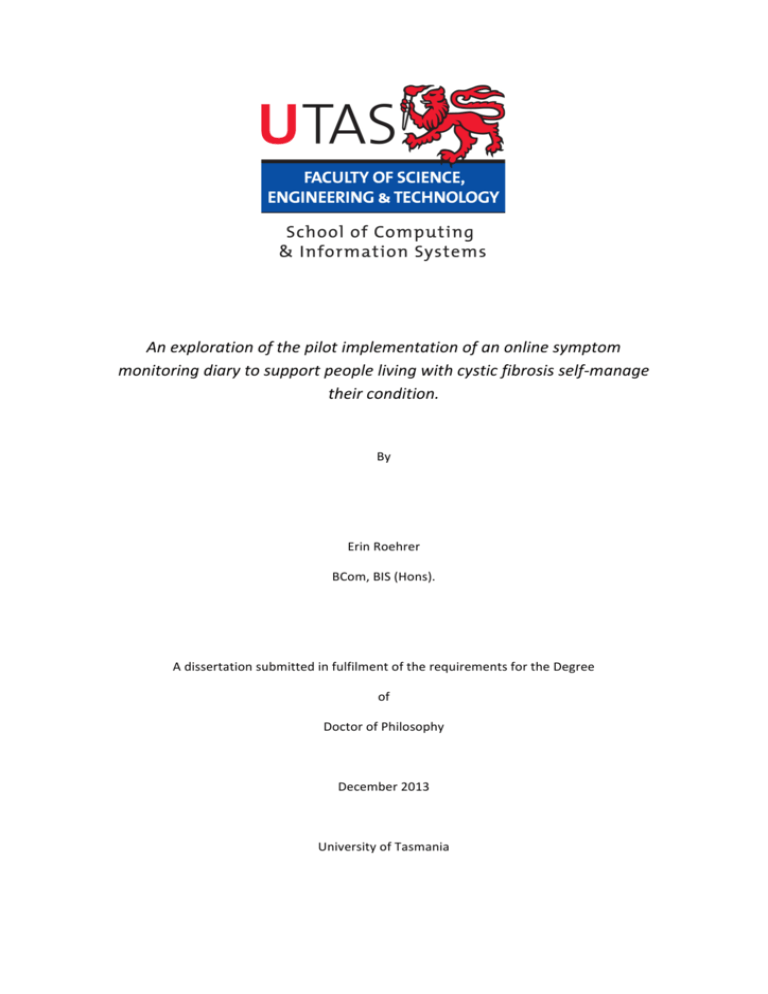
An exploration of the pilot implementation of an online symptom monitoring diary to support people living with cystic fibrosis self-­‐manage their condition. By Erin Roehrer BCom, BIS (Hons). A dissertation submitted in fulfilment of the requirements for the Degree of Doctor of Philosophy December 2013 University of Tasmania This dissertation contains no material which has been accepted for the award of any degree of diploma by the University of Tasmania or any other institution, except by way of background information and duly acknowledged in the thesis, and to the best of the candidate’s knowledge and belief no material previously published or written by another person except where due acknowledgment is made in the test of the thesis. This thesis may be made available for loan and limited copying in accordance with the Copyright Act 1968. Erin Roehrer A B S T R A C T This thesis explores the pilot implementation of an online symptom monitoring diary (myCF pilot implementation) developed to support people living with cystic fibrosis (CF) through symptom monitoring. The research was conducted within a broader study, the myCF project, that was implementing an online symptom monitoring diary in Tasmania. The myCF pilot implementation was designed in conjunction with health care practitioners with the intention of increasing the patient's symptom awareness and in turn their CF self-­‐ management. This thesis presents findings on how the myCF pilot implementation was incorporated into the daily lives of people living with CF and how the myCF pilot implementation influenced people’s ability to self-­‐manage. More broadly, guided by the use of Normalisation Process Theory, this thesis contributes to improving understanding of the socio-­‐technical factors and processes that arise during the integration of online symptom monitoring with supporting chronic disease self-­‐management. ICT tools have been proposed as a mechanism to contribute to improving people’s self-­‐ efficacy for managing their condition, which in turn lead to improved health outcomes (Cummings et al., 2010, Ekberg et al., 2010). There is a need for more qualitative research to understand the requirements for ICT self-­‐management tools (Ahern, 2007) and to improve the efficacy of these tools (Gomez and Pather, 2012, Cummings, 2008). This research explores the potential link between self-­‐management tool efficacy and developing self-­‐ management ‘knowledge’. ICT tools that are specifically designed to support individuals in symptom monitoring are still in their infancy and there is minimal evidence of the implementation of such tools (Gaikwad and Warren, 2009, Nijland et al., 2008, Solomon, 2008). Currently most self-­‐management tools include a monitoring component with reporting back to health care professionals for decision making on the management of the patient’s condition (Hardiker et al., 2013, McDermott and While, 2013). The monitoring of symptom data by health care professionals contradicts the foundations of self-­‐management, aligning the self-­‐management tool to a compliance model. CF has been identified as a chronic condition where patients could potentially benefit from ICT supported self-­‐ management. CF is one of the most common life-­‐threatening genetic diseases, Tasmania has a high incidence of CF and much of the CF population is geographically dispersed and socially isolated. This thesis contributes to the current substantive and conceptual knowledge to the field of information systems by presenting findings on the interactions between the online symptom monitoring diary and CF in Tasmania. The research methodology employed a qualitative approach that was underpinned by a subjective ontology and an interpretative epistemology. The research strategy consisted of a case study and a three-­‐stage data collection over 6 months. Three groups of participants were involved in this research, for all three stages. These groups are: 1. Children (0-­‐10 years) and a parent; 2. Teenagers (11 to 17 years) with CF, a parent may have been included; and 3. Adults (18 years plus) with CF. i The research design consisted of three research stages: Stage one explored participants’ expectations and the initial introduction to the myCF pilot implementation by conducting semi-­‐structured interviews, observations, and field notes. Stage two explored the participants’ experiences of the myCF pilot implementation and utilised semi-­‐structured interviews, observations, field notes and web-­‐logs. Stage three used unstructured interviews to develop individual case studies and additionally used data collected from the first two research stages. Data was analysed with an inductive thematic approach that developed abstracted themes, which generated insight and discussion from three different lenses for this research; the research stages, the individual cases, and at a holistic level. The themes were interpreted to gain insights for each research stage, resulting in the development of initial findings. Concept maps were used to identify clusters of the initial findings and to enhance the interpretation of the initial findings from all three stages of the research. The interpretation process resulted in research findings that represented both individual and group experiences. Further interpretation of the research findings, assisted by the use of Normalisation Process Theory, answered the research questions and research objectives, producing the final four key findings. In order to understand in detail the attitudes, insights, perceptions, and individual CF attributes over times as they interact with the myCF pilot implementation, a qualitative approach was adopted. The key findings for the research are as follows: o KF1: Without a transition from self-­‐management ‘understanding’ to self-­‐management ‘knowledge’ it is not possible for an online symptom monitoring diary to provide self-­‐management support. o KF2: Symptom monitoring is a background activity for those with CF, and a focused activity for those who care for people with CF. o KF3: Evaluation methods that focus on use of electronic tools for self-­‐management support are not able to holistically capture all aspects of perception of helpfulness. o KF4: Lack of consistency in user-­‐interface design directly impacted on perceptions of satisfaction during interaction and overall evaluations of the entire online symptom monitoring diary. This research has made contributions to information systems knowledge at substantive, methodological and theoretical levels. At a substantive level it has provided a case study of how the myCF pilot implementation was incorporated into the lives of participants, and how self-­‐management support was not evident from the pilot implementation. At a methodological level the design of this research has demonstrated the value of linking the analysis of the research stages through inductive thematic analysis. The thematic analysis moved the segmented data to abstracted themes that facilitated individual case development of the participants’ experiences during the research. The interpretation of the ii analysis through the use of a concept map developed the basic initial findings into comprehensive research findings that reflected both the individual and group perspectives present in this research. At a theoretical level, using the knowledge management hierarchy, the research has highlighted that the myCF pilot implementation does not support self-­‐ management without a transition from self-­‐management ‘understanding’ to self-­‐ management ‘knowledge’. The research has demonstrated that current evaluation techniques do not capture the intangible criteria that indicate whether the myCF pilot implementation was a success or a failure. Finally, this research has demonstrated that before technology is implemented to support people living with CF with symptom monitoring and self-­‐management, we first need to be aware of what the participants understand self-­‐management to consist of. iii A C K N O W L E D G M E N T S I gratefully acknowledge the support and guidance provided by my team of supervisors – Dr. Elizabeth Cummings, Dr. Leonie Ellis, and Associate Professor Paul Turner. Thank you all for your encouragement and challenges you all provided me during my candidature, it has made this journey both rewarding and exciting. I would especially like to thank my primary supervisor, Dr. Elizabeth Cummings, for her continuous assistance and dedication during my candidature. I would also like to add additional thanks to Dr. Leonie Ellis, for her friendship and encouragement to undertake this PhD. To my husband Gernot, I would not have started this journey if it wasn’t for your unwavering support, enthusiasm and belief. Thank you for always believing in me, listening to me and calming me down when it all got too much. To William and Luke, Mummy is so proud of how understanding you have been over the last 3.5 years. You have provided a source of inspiration and distraction. To Mum, Dad, Annette, Siggy, thank you for everything – the babysitting, meals and unconditional encouragement you have provided to Gernot and I. To Clare, Chris, Sam, Hannah, Hagen and Antonia, thank you for all continuous support. Special thanks to Meredith Castles and Ming Chao Wong for proof reading this thesis. I would also like to thank Ming Chao for all her friendship and encouragement during my candidature. I would also like to thank the members of the eHealth Services Research group, my friends, my fellow PhD colleagues and my office mate Lisa, for providing a fun and supportive environment to work in and the willingness for a coffee or two. Thank you also to the Tasmanian Community Fund Project (myCF) Team for the opportunity to work with the team and for their ongoing support. I would like to acknowledge the support of the Tasmanian Community Fund. Thank you to all the anonymous referees from the following conferences and journals for their valuable feedback. I would also like to acknowledge the contributions made by my co-­‐ authors in these publications: o o o o o Information Technology and Communications in Health (ITCH) 2011 Health Informatics Conference (HIC) 2012 Information Technology and Communications in Health (ITCH) 2013 Journal of Informatics for Health and Social Care (2013) International Journal of Healthcare Technology and Management (2013) Finally, I would like to dedicate this research to my sons. William and Luke – you have had patience when I had none, laughter when I had tears, and the power to make it all better with just one hug. ♥ iv A C R O N Y M S BMI Body Mass Index CCM Chronic Care Model CDSM Chronic Disease Self-­‐Management CF Cystic Fibrosis COPD Chronic Obstructive Pulmonary Disease CSCW Computer-­‐Supported Co-­‐operative Work EBM Evidence-­‐Based Medicine FEV1 Forced Expiratory Volume in 1 second FVC Forced Vital Capacity GDP Gross Domestic Product GP General Practitioner HCI Human Computer Interaction ICT Information Communication Technology IS Information Systems ISDM Information Systems Development Methodologies IT Information Technology PC Personal Computer PD Participatory Design NPT Normalisation Process Theory RCT Randomised Controlled Trial SDLC Systems development life cycle SLT Social Learning Theory SMS Short Message Service TCF Tasmanian Community Fund TPB Theory of Planned Behaviour TRA Theory of Reasoned Action v TTMC Trans-­‐theoretical Model of Change UCD User Centred Design UI User-­‐Interface vi T A B L E O F C O N T E N T S ABSTRACT ........................................................................................................................... I ACKNOWLEDGMENTS ....................................................................................................... IV ACRONYMS ........................................................................................................................ V TABLE OF CONTENTS ........................................................................................................ VII TABLE OF TABLES ............................................................................................................. XII TABLE OF FIGURES .......................................................................................................... XIII CHAPTER 1 INTRODUCTION ............................................................................................ 1 1.1 INTRODUCTION ................................................................................................................ 1 1.2 RESEARCH DOMAIN .......................................................................................................... 2 1.3 RESEARCH PROBLEM DEFINED ............................................................................................ 5 1.3.1 Research Aims ....................................................................................................... 7 1.3.2 Research Questions ............................................................................................... 7 1.3.3 Research Approach ............................................................................................... 7 1.4 SUMMARY OF CONTRIBUTION ............................................................................................ 8 1.5 SUMMARY OF CHAPTERS ................................................................................................. 10 1.5.1 Chapter 2 Background ......................................................................................... 11 1.5.2 Chapter 3 Literature Review ................................................................................ 11 1.5.3 Chapter 4 Research Methodology ....................................................................... 11 1.5.4 Chapter 5 Stage one: Foundation building .......................................................... 11 1.5.5 Chapter 6 Stage two: Implementation Experience .............................................. 12 1.5.6 Chapter 7 Stage three: Life context ..................................................................... 12 1.5.7 Chapter 8 Discussion of findings ......................................................................... 12 1.5.8 Chapter 9 Conclusion ........................................................................................... 12 1.6 CHAPTER SUMMARY ....................................................................................................... 12 CHAPTER 2 BACKGROUND ............................................................................................ 14 2.1 INTRODUCTION .............................................................................................................. 14 2.2 BACKGROUND TO THE MYCF PROJECT ................................................................................ 15 2.2.1 Pathways home ................................................................................................... 15 2.2.2 CFA Project .......................................................................................................... 16 2.3 MYCF PROJECT ............................................................................................................... 17 2.4 MYCF PILOT ................................................................................................................... 20 2.4.1 The implemented system .................................................................................... 21 2.5 CHAPTER SUMMARY ....................................................................................................... 23 CHAPTER 3 LITERATURE REVIEW ................................................................................... 25 3.1 INTRODUCTION .......................................................................................................... 25 3.2 BACKGROUND ................................................................................................................ 26 3.2.1 Changing health care demographics ................................................................... 26 3.2.2 Information and Communication Technology (ICT) in health care ...................... 27 vii 3.2.3 What is eHealth? ................................................................................................. 30 3.3 ICT FOR SYMPTOM MONITORING ...................................................................................... 32 3.3.1 ICT development .................................................................................................. 33 3.3.2 ICT evaluation ...................................................................................................... 35 3.3.3 Defining the user ................................................................................................. 40 3.3.4 The digital divide ................................................................................................. 40 3.3.5 ICT symptom feedback ........................................................................................ 41 3.4 SELF-­‐MANAGEMENT ....................................................................................................... 42 3.4.1 Health Information seeking behaviour ................................................................ 43 3.4.2 Partnership in health care ................................................................................... 44 3.5 CYSTIC FIBROSIS, ATTITUDES AND LIFE ................................................................................ 46 3.5.1 Cystic fibrosis -­‐ a Tasmanian context .................................................................. 47 3.5.2 Delivery of cystic fibrosis care ............................................................................. 47 3.5.3 Impact of cystic fibrosis on individual and family ................................................ 48 3.6 CHAPTER SUMMARY ....................................................................................................... 49 CHAPTER 4 RESEARCH METHODOLOGY ......................................................................... 52 4.1 INTRODUCTION .............................................................................................................. 52 4.2 RESEARCH PHILOSOPHY ................................................................................................... 53 4.2.1 Ontology .............................................................................................................. 53 4.2.2 Epistemology ....................................................................................................... 54 4.2.3 Qualitative methodology .................................................................................... 55 4.3 RESEARCH STRATEGY ...................................................................................................... 58 4.3.1 Case study ........................................................................................................... 59 4.3.2 Three stage data collection ................................................................................. 61 4.4 RESEARCH DESIGN .......................................................................................................... 61 4.5 TOOLS AND TECHNIQUES .................................................................................................. 63 4.5.1 Interviews ............................................................................................................ 64 4.5.2 Semi-­‐structured interviews .................................................................................. 65 4.5.3 Observation ......................................................................................................... 67 4.5.4 Field Notes ........................................................................................................... 67 4.5.5 Web-­‐logs ............................................................................................................. 68 4.5.6 Unstructured interviews ...................................................................................... 68 4.5.7 Ethics ................................................................................................................... 69 4.6 DATA ANALYSIS .............................................................................................................. 69 4.6.1 Theory of analysis ................................................................................................ 70 4.6.2 Analytical approach ............................................................................................ 71 4.7 INTERPRETATION AND DISCUSSION .................................................................................... 78 4.7.1 Concept Maps ..................................................................................................... 78 4.8 RESEARCHER BIAS ........................................................................................................... 80 4.9 CHAPTER SUMMARY ....................................................................................................... 82 CHAPTER 5 STAGE ONE -­‐ FOUNDATION BUILDING ........................................................ 83 5.1 INTRODUCTION .............................................................................................................. 83 5.2 RESEARCH STAGE ONE – FOUNDATION BUILDING ................................................................. 84 5.3 STAGE ONE THEMES ........................................................................................................ 84 viii 5.3.1 Condition ............................................................................................................. 84 5.3.2 Management ....................................................................................................... 89 5.3.3 Support ................................................................................................................ 91 5.3.4 Considerations ..................................................................................................... 95 5.3.5 Expectations ...................................................................................................... 100 5.3.6 Development ..................................................................................................... 103 5.3.7 Blockage ............................................................................................................ 106 5.4 STAGE ONE – FOUNDATION BUILDING INITIAL FINDINGS ...................................................... 109 5.5 CHAPTER SUMMARY ..................................................................................................... 111 CHAPTER 6 STAGE TWO -­‐ IMPLEMENTATION EXPERIENCE .......................................... 112 6.1 INTRODUCTION ............................................................................................................ 112 6.2 STAGE TWO – IMPLEMENTATION EXPERIENCE THEMES ....................................................... 113 6.2.1 Expectations ...................................................................................................... 113 6.2.2 Relevance .......................................................................................................... 115 6.2.3 Usability ............................................................................................................ 118 6.2.4 Facilitation ......................................................................................................... 123 6.2.5 Connecting ........................................................................................................ 125 6.2.6 Care ................................................................................................................... 129 6.2.7 Apathy ............................................................................................................... 133 6.2.8 Life ..................................................................................................................... 135 6.3 STAGE TWO – IMPLEMENTATION EXPERIENCE INITIAL FINDINGS ............................................ 140 6.4 CHAPTER SUMMARY ..................................................................................................... 143 CHAPTER 7 STAGE THREE – LIFE CONTEXT ................................................................... 144 7.1 INTRODUCTION ............................................................................................................ 144 7.2 STAGE THREE – LIFE CONTEXT THEMES ............................................................................. 146 7.3 CASE STUDY A ............................................................................................................. 147 7.3.1 Dennis ................................................................................................................ 147 7.3.2 Comparision of case to stage two analysis ....................................................... 150 7.4 CASE STUDY B ............................................................................................................. 152 7.4.1 Iain .................................................................................................................... 152 7.4.2 Comparision of case to stage two analysis ....................................................... 154 7.5 CASE STUDY C ............................................................................................................. 156 7.5.1 Keir .................................................................................................................... 156 7.5.2 Comparision of case to stage two analysis ....................................................... 159 7.6 CASE STUDY D ............................................................................................................. 161 7.6.1 Jarrett ................................................................................................................ 161 7.6.2 Comparision of case to stage two analysis ....................................................... 166 7.7 CASE STUDY E .............................................................................................................. 168 7.7.1 Nate ................................................................................................................... 168 7.7.2 Comparision of case to stage two analysis ....................................................... 170 7.8 CASE STUDY F .............................................................................................................. 172 7.8.1 Saxon ................................................................................................................. 172 7.8.2 Comparision of case to stage two analysis ....................................................... 175 7.9 CASE STUDY G ............................................................................................................. 177 ix 7.9.1 Wallace ............................................................................................................. 177 7.9.2 Comparision of case to stage two analysis ....................................................... 179 7.10 CASE STUDY H ............................................................................................................. 181 7.10.1 Martin ............................................................................................................. 181 7.10.2 Comparision of case to stage two analysis ..................................................... 184 7.11 CASE STUDY I .............................................................................................................. 185 7.11.1 Nyda ................................................................................................................ 185 7.11.2 Comparision of case to stage two analysis ..................................................... 187 7.12 CASE STUDY COMPARISIONS ........................................................................................... 189 7.13 STAGE THREE – LIFE CONTEXT INITIAL FINDINGS ................................................................. 194 7.14 RESEARCH FINDINGS ..................................................................................................... 196 7.15 CHAPTER SUMMARY ..................................................................................................... 200 CHAPTER 8 DISCUSSION OF FINDINGS ......................................................................... 201 8.1 INTRODUCTION ............................................................................................................ 201 8.2 FINDINGS .................................................................................................................... 202 8.2.1 Finding One ....................................................................................................... 202 8.2.2 Finding Two ....................................................................................................... 203 8.2.3 Finding Three ..................................................................................................... 205 8.2.4 Finding Four ...................................................................................................... 206 8.2.5 Finding Five ....................................................................................................... 207 8.2.6 Finding Six ......................................................................................................... 209 8.2.7 Finding Seven .................................................................................................... 212 8.2.8 Finding Eight ..................................................................................................... 214 8.3 ANSWERING THE RESEARCH QUESTIONS AND OBJECTIVES .................................................... 216 8.4 RESEARCH KEY FINDINGS ............................................................................................... 224 8.4.1 Key Finding One ................................................................................................. 224 8.4.2 Key Finding Two ................................................................................................ 226 8.4.3 Key Finding Three .............................................................................................. 227 8.4.4 Key Finding Four ................................................................................................ 229 8.5 CHAPTER SUMMARY ..................................................................................................... 231 CHAPTER 9 CONCLUSION ............................................................................................ 232 9.1 INTRODUCTION ............................................................................................................ 232 9.2 SUMMARY OF RESEARCH FINDINGS .................................................................................. 233 9.2.1 RQ1: Supporting self-­‐management ................................................................... 233 9.2.2 RQ2: Incorporating symptom monitoring ......................................................... 234 9.3 RESEARCH CONTRIBUTIONS ............................................................................................ 235 9.3.1 Substantive level ............................................................................................... 235 9.3.2 Methodological level ......................................................................................... 236 9.3.3 Theoretical level ................................................................................................ 237 9.4 IMPLICATIONS FOR PRACTICE .......................................................................................... 238 9.5 RESEARCH LIMITATIONS ................................................................................................. 238 9.5.1 Scope of research .............................................................................................. 239 9.5.2 Researcher bias ................................................................................................. 239 9.5.3 Lack of generalisability ...................................................................................... 240 x 9.6 FUTURE RESEARCH ....................................................................................................... 240 9.7 SUMMARY .................................................................................................................. 241 REFERENCES ................................................................................................................... 243 APPENDIX A PRE-­‐IMPLEMENTATION QUESTIONS ........................................................... 263 APPENDIX B DIARY USER GUIDE ..................................................................................... 264 APPENDIX C POST-­‐IMPLEMENTATION QUESTIONS ......................................................... 280 APPENDIX D FIELD NOTE EXAMPLE ................................................................................ 282 APPENDIX E INTERPRETATION CONCEPT MAP ................................................................ 283 APPENDIX F FINDING ONE CONCEPT MAP ...................................................................... 284 APPENDIX G FINDING TWO CONCEPT MAP .................................................................... 285 APPENDIX H FINDING THREE CONCEPT MAP .................................................................. 286 APPENDIX I FINDING FOUR CONCEPT MAP .................................................................... 287 APPENDIX J APPENDIX FIVE CONCEPT MAP .................................................................... 288 APPENDIX K FINDING SIX CONCEPT MAP ....................................................................... 289 APPENDIX L FINDING SEVEN CONCEPT MAP ................................................................... 290 APPENDIX M FINDING EIGHT CONCEPT MAP .................................................................. 291 xi

